

|
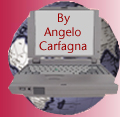
|
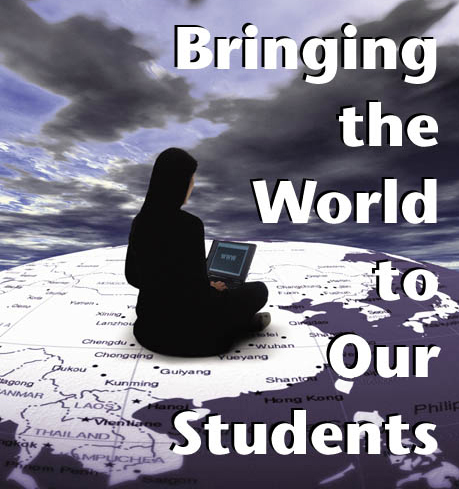
Imagine:
Such interactions are rare for most college students; but they happen daily at Fairleigh Dickinson University. Here, students travel on an educational odyssey around the globe without leaving their computers. As part of the University’s acclaimed distance-learning initiative (see Global Connections a Click Away), Global Virtual Faculty (GVF) — scholars and practitioners based around the world — participate in online courses and bring a new dimension to the learning experience. Via e-mail and Internet discussion boards, the Global Virtual Faculty interact directly with students and faculty, offer unique insights and diverse observations on course topics, present relevant material or case studies and point students to useful Web sites and other resources. “Most universities view online learning as a vehicle to bring programs to students throughout the world,” says President J. Michael Adams. “In contrast, our main motivation, as part of our mission to prepare global citizens, is to bring the world to our students.” FDU’s Director of Global Initiatives Dalila Suhonjic has led the program from the beginning and oversees the involvement of these internationally respected individuals. She explains that on-campus faculty are responsible for the syllabus, assignments and evaluations, while guiding the participation of the GVF. Thus far, she adds, 35 Global Virtual Faculty have contributed to online courses, and more are joining each semester. Cross-cultural DialogueIn Unit Four of The Global Challenge, the freshman online University Core course, the discussion turns to the global environment and global poverty. Sheila Arbilo, a finance major on the Metropolitan Campus, laments the fact that despite great technological advances, little progress has been achieved in combating food shortages. She suggests that genetically modified foods (GMFs) could provide a possible solution. But are there any pitfalls? 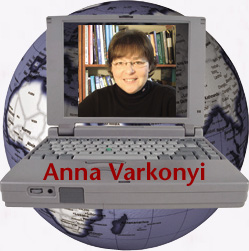
Hungarian environmentalist and GVF member Anna Varkonyi is in a great position to add insight to the subject. She served as a researcher with the Hungarian Commission on Sustainable Development and was a Hungarian government representative at the fifth session of the Commission on Sustainable Development and the U.N. General Assembly Special Session. An environmental journalist, she has participated in many international environmental events, including the 1992 Earth Summit follow-up in Geneva, Switzerland. “The GMFs are only one of the tools,” she responds to Arbilo, adding a quote from the 1992 Earth Summit: “An effective strategy for tackling the problems of poverty, development and environment simultaneously should begin by focusing on resources, production and people and should cover demographic issues, enhanced health care and education, the rights of women, the role of youth and of indigenous people and local communities and a democratic process in association with improved governance.” In other words, Varkonyi speaks of an integrated approach. Arbilo reflects on the point and concludes that “an overall improvement to a society needs to be made in order to allay any part of the global poverty problem.” |
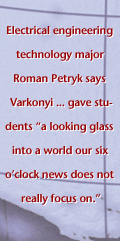
|
Such lessons are commonplace, Arbilo says, as Varkonyi “brought up many topics that were interesting and relevant to local situations. Her comments were thoughtful and insightful, making us really think about our discussion.” Electrical engineering technology major Roman Petryk says Varkonyi “brought a European flavor to the conversations.” He says she spoke of international issues “from her portion of the globe” and gave students “a looking glass into a world our six o’clock news does not really focus on.” Specifically, Petryk adds, Varkonyi “enhanced the subject matter by giving examples of pollution, politics and human nature in her locale that mirror what we see here. These common threads help sow the feeling of a global community. We may be far apart but we face many of the same trials and tribulations.” Through the lessons from Varkonyi, Arbilo gained a greater appreciation for the importance of broadening one’s outlook. “You have to be willing to open yourself to new people and experiences. These new ideas can help you become a better person.” From her standpoint, Varkonyi feels the students have “opened their eyes and responded smartly. They are very enthusiastic about environmental issues and share their experiences.” Core BenefitsThe Global Challenge is not only the first leg of the distance-learning initiative but also the initial University Core class. Philosophy professor James Kuehl, the University Core director at the College at Florham, says one of the primary goals of the Core program is “to encourage students to understand perspectives quite unlike their own.” Working with GVF, he says, “greatly assists us in doing that. The Global Virtual Faculty that I know have an enthusiasm for global issues that is entirely infectious.” 
In teaching The Global Challenge, Kuehl wanted GVF to help students better understand the economic meaning of globalization. His GVF partners have included Australian economist Amir Mahmood, director of Australasia International Development Consulting, and Cheng Ming Yu, head of the economics unit of the faculty of management at the Multimedia University in Malaysia. “They were very sensitive and helpful in addressing student questions and mine,” Kuehl says. “These good colleagues from far away places put the human face on the issues that matter to our species.” Cheng has found FDU students to be “sharp and critical.” She believes it is vital that students are “exposed to different opinions from different perspectives, particularly for discussions involving different cultures and different economic development patterns and policies.” Mahmood adds that with the globalization of markets and production as well as advances in technology, “the world is becoming more integrated than ever. This interdependence calls for a global response to challenges resulting from globalization.” 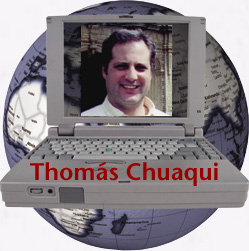
Fellow GVF member Tomás Chuaqui agrees. A political science professor at the Instituto de Ciencia Politica of the Pontificia Universidad Católica de Chile, Chuaqui says, “It is important in an ever-increasing worldwide interconnectedness that students discover that it is possible to relate to people who have strikingly different life experiences.” He adds that he has been pleased by the level of interaction. “It is exciting to see the students react to a posted message, work through an issue in a series of posts as they refine their arguments and respond to challenges posed by their peers and professors.” Rising to the ChallengeIn another section of The Global Challenge, professor Elizabeth Bisbing recently partnered with GVF member Ben Duncan, a media officer for the European Commission. Duncan was previously a European Union (EU) lobbyist whose major campaigns included raising EU minimum training requirements for general medical practitioners to three years and a directive on labeling presentation and content of tobacco products. He now helps communicate EU policies on health and consumer protection. |
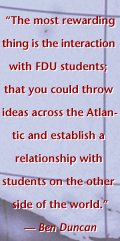
|
Duncan, who is from the United Kingdom, recognizes the significant differences between himself and the FDU students. “My life is very different from the life of a New Jersey freshman. But the fact that we are different gives us plenty to talk about. I really feel the students rise to the challenge. They enjoy getting perspectives from the other side of the Atlantic.” Duncan also relished the chance to learn from the students about things like New Jersey landfills. “The most rewarding thing is the interaction with FDU students; that you could throw ideas across the Atlantic and establish a relationship with students on the other side of the world, I find that very rewarding.” Bisbing says the students “particularly liked Duncan’s input” and that he engaged them by asking thoughtful questions. “One student said, ‘Even though he knows so much, I never felt he was talking down to me.’” She adds that Duncan “showed all of us that there is more than one way of looking at the world and all of the issues we face as a global community. I think he helped the students to understand that they need to think more about the world and not just consider themselves and the United States.” 
For Duncan, the GVF program highlights the most valuable part of a good education. “The whole point of university education is to teach students how to think. The best way [to do that] is to have your views challenged by someone who sees things from a completely different perspective.” Such is the promise of the Global Virtual Faculty program. FDU Assistant Professor of Philosophy and Political Science Jason Scorza helped design and teaches both The Global Challenge and the sophomore online course The Life of the Mind. He has worked closely with three Global Virtual Faculty members, including Varkonyi and Chuaqui. “Working with GVFs has been a pleasure,” he says, adding that they contribute “expertise and stimulating discussion.” He explains, “When dealing with global questions, the alternative perspectives provided by them are invaluable to learning.” In The Life of the Mind, Scorza aims to show students the practical applications of philosophical ideas. Toward that end, he is partnering with GVF member James Gallagher to explain how the philosophy of science is applied in forensic investigations. Gallagher, a member of the British Academy of Forensic Science and Forensic Science Society, retired from the Metropolitan Police Service (Scotland Yard) after 34 years of duty. He worked as a detective crime-scene coordinator whose areas of expertise included crime-pattern analysis, body recovery, fire-scene investigation and offender profiling. He now is a consultant in the fields of training and development for crime-scene management, crime-scene investigation, interpretation and examination. Psychology major William Catogge says Gallagher proved very instrumental to the class. “We had some discussion questions and lessons on how to solve a murder, and he was extremely helpful.” Laura Figueiredo, a student who works as a computer programmer/analyst, also benefited from Gallagher’s contributions. She says he brought “a wealth of knowledge and advice on how to apply inductive and deductive reasoning to solving crimes or other problems.” She specifically learned that “while most crimes may be universal, the approaches to solving them can be quite different around the world.” She adds that she was “in awe” at the chance to “speak” with someone of Gallagher’s credentials. “What a wonderful opportunity it was to correspond with a real, live person who had actually investigated over 1,000 crime scenes! Having such a person involved in our course helped to give us a better sense of realism as we studied the application of reasoning and logic in determining truth.” The Learning CurveOnline learning presents new challenges, sometimes more for the faculty than the students. After being nominated by FDU faculty and accepted into the program, GVF members participate in an online training program that helps address these challenges and familiarizes them with the details and goals of the program. Still, the adjustment takes time. GVF particularly mention the difficulty of not having face-to-face contact, and they also worry about technical problems. Duncan notes, “In a text-based discussion board, you do not get the immediate feedback and interaction that occurs in a face-to-face seminar. If you are all sitting round a table together, you can pick up pretty quickly from people’s body language if they are interested in what you are saying. In an online discussion, everyone — teachers and students — has to work harder.” Duncan adds that because all students must participate and postings can be made at anytime, teachers have more to consider and evaluate. “An online course can soak up a lot of hours.” In his 30-year career as special correspondent, resident editor and editor of the Economic Times, The Observer and Maharashtra Times in India, Kumar Ketkar has covered four U.S. presidential elections, two British elections, the collapse of the Soviet Union (from Moscow), Hong Kong’s reintegration with mainland China (from Hong Kong) and the unification of Germany (from Bonn and Berlin). He recently took the position of editor-in-chief and CEO of the well-known newspaper group Lokmat. An original GVF member, he knows well the pros and cons of the format. 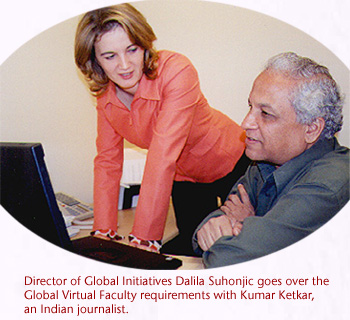
The biggest disadvantage, he says, is that the “faculty do not get the opportunity to meet students.” To combat this problem, Ketkar has visited FDU to address the students personally. He also encourages opportunities for students to meet with each other. (The Global Challenge course does have several classroom sessions.) There is also the issue of communication between the GVF and the on-campus faculty. Without routine personal interaction, regular and effective communication becomes critical. Scorza notes, “It is very important to establish a mutual understanding of expectations and roles at the very beginning of the semester so the GVF understand clearly what is expected of them.” Students, too, have seen some pitfalls. “You have very little personal interaction with the students and the professor,” Catogge says. He adds that it also can be frustrating waiting for discussion responses or dealing with Internet problems. He says there’s sometimes the feeling that “you are swimming in the sea by yourself.” Other students particularly acknowledge the technical challenges. Petryk says there can be difficulties logging on during times of high usage. But, he adds, it is possible to circumvent this problem by recognizing those times and modifying your Web use. “It is no different than expecting lines in a cafeteria around meal times.” Even with some shortcomings, all involved recognize the unique opportunities provided by this format. Ketkar says that what he most appreciates is the “idea of trying to integrate the world through modern technology.” He adds that online learning “gives freedom of time and space. It liberates the students as well as the academic faculty from the constraints of being present at a particular time and at a specific place.” As Duncan says, “This flexibility makes the whole thing possible. Remember, I am six time zones to the east of the students.” That flexibility is equally valued by the students. Catogge says, “You learn on your own time and at your own pace.” Another online advantage for students, Arbilo points out, “is that you have the ability to make connections with everyone in the class. You also have more time to think about what you are going to say. The result is heartfelt, well-written answers and responses.” Fellow student Figueiredo agrees, “There are times when I wish we could be in class together, but I feel like I’m getting to know people so much better this way. This format makes it so much easier for people to ‘speak’ freely, to obtain assistance and/or feedback and to absorb it and then respond on another day. The online format gives everyone equal opportunity to participate.” Petryk also notes that the lack of face-to-face interaction has an upside. “Being online concentrates on content, the idea, the question or the message,” he says. “It is communication without preconception and in some ways without prejudice. The focus is on the message and not the messenger.” Like the professors observe, students say that online courses can require more time and discipline. “You really have to be an active participant,” Arbilo says. “You must set a definite schedule of when you will type responses and when you will turn in assignments. You cannot be a passive learner.” And both faculty and students are unanimous in praising the value of collaborative learning across oceans and cultures. With the technology, says GVF member Ketkar, “it is possible to create global virtual communities, to create global universities and to facilitate worldwide dialogue.” Petryk agrees, “The wonder of instant contact and communications with individuals from other parts of the globe opens up many avenues. No matter how we profess to be objective, many of us are exposed to the same regional and national information flows.” He believes the GVF add “dimension and depth and were pivotal in rounding out the curriculum.” ‘A Visionary Program’While Global Virtual Faculty receive an honorarium (either $500 or 1,000 per course, depending on the level of involvement), they commonly say this worldwide dialogue is what draws them into the program. GVF member Duncan said he felt from the beginning it “sounded like a visionary program. To have teachers in different continents interact with students in New Jersey seemed like an ideal way to use the Internet in education. I wanted to be part of the project.” |
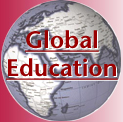
|
Calling Fairleigh Dickinson “an exciting academic community,” Chuaqui says part of the proof lies “precisely in its efforts to push forward the inclusion of new technologies in higher education, allowing people from different cultures to share perspectives on issues of global significance.” He also sees such use of technology in education becoming more prevalent. “In a certain sense, students are way ahead of us. They have lived most of their lives knowing that there is such a thing as the Internet. Surely, as educators we are catching up to them in this regard.” He believes that “there is no question that the trend to incorporate online learning technologies will continue, and its advantages in terms of allowing students to access global perspectives will be exploited more and more.” Other GVF also see the likely use of FDU’s program as a model for other universities. Not only is learning online an essential life skill, they say, but the value of understanding global views is growing more and more critical. “I have no doubt that this is way ahead,” Mahmood says from Australia. Ketkar, in India, agrees, saying the flexibility and versatility of the format will persuade others to follow. And writing from Malaysia, Cheng believes “this learning model should be adopted in other universities, not only in the United States, particularly when the world is becoming more interlinked.” Working so closely with the GVF from his Teaneck office, Scorza says the basic concept is certainly far from new. “People have been inviting colleagues to visit their classrooms as guest lecturers for a very long time.” But combining that concept with the capabilities of the Internet may indeed be the wave of the future, he says, for strong educational reasons as well as very practical ones. “The appeal of bringing in dozens of guest lecturers from around the world via the Internet, without the expense of flying them to the United States and paying their accommodations, will probably be hard to resist.” It may be too soon to tell whether GVF-like programs will begin sprouting up around the world. But its importance to Fairleigh Dickinson University is not in doubt. Over the next four to five years, Fairleigh Dickinson will expand its online course offerings to nearly 100 courses, some common to all students, some specific to a discipline. For those course offerings, it hopes to build its Global Virtual Faculty to approximately 75 members. 
“In today’s world we need global citizens who understand and can adapt to cultural differences,” said President Adams. “The Global Virtual Faculty provide an exciting new dimension to the learning experience. They help our students look at problems and issues through the eyes of others. That is part of the process of becoming a global citizen.” More information about the Global Virtual Faculty and the distance-learning initiative is available on FDU’s global education Web site, www.globaleducation.edu. |
|
Global Connections a Click Away FDU Magazine Directory | Table of Contents | FDU Home Page | Alumni Home Page | Comments |
|